Pasta Basta (or home made pasta)
No, that’s not a name of an obscure pasta dish, or anything near – just the title for my blog post on how to make pasta from scratch.

I enjoy cooking with store bought pasta (Barilla) but for certain dishes I like having home made fresh pasta (Pasta Fresca), since it adds a whole new dimension to the equation.
The Pasta Recipe (updated!)
Dear Mamaliga fans! I just realized (at some of your comments) that I was so busy explaining the pasta making procedure that I completely forgot the pasta recipe! My apologies and here it is for a batch that can fee say 4 people:
- 5 cups pastry flour (low-gluten or tipo 00)
- 6 extra large eggs
Sometimes if I want a more richer (and more yellow) pasta, I use 12 egg yolks instead of the 6 whole eggs.
The Egg, Then The Pasta!
Besides the fact that home made fresh pasta has a distinct flavor, texture and richness, it also looks gorgeous on a plate, depending on how many eggs — and more importantly, what kind of eggs you use.
I keep dreaming about having a small flock of chickens in my Chicago NW suburban backyard (as I had back in Romania), but until the “Live Off Your Land” bill passes the House, I will have to be happy with the most cage-free, free-range, natural, brown eggs I could find on the market (sigh).
If you get a chance to lay your hands on some fresh farm eggs from your local farmer, chances are that you might be preparing a 5 star fresh pasta next. Read on.
Flour Types
While all-purpose dominates as the flour of choice for fresh pasta don’t be afraid to experiment with different types, like semolina flour for instance. It adds a nice surface roughness which sauce sticks to well, etc. Here I am using approximately half and half (all-purpose and Semolina flour). Usually mix the two together before adding the eggs.
Update: also try using low-gluten flour (aka pastry flour or the Italian tipo 00), it will have a finer texture and will be easier to roll since you won’t battle with the gluten elasticity, that makes a rubbery dough.
The Volcano’s Crater
As I am writing (and as you read), there are numerous Mammas (and Papas) in rural Italy that are preparing pasta using this very ancient method and one of the best “food processors” available – their hands.
[ad#468×60]
They gather the flour into a mound, then form a “crater” in the middle with a wall high enough that will keep the eggs inside, and start mixing the eggs with the flour, little by little until the dough becomes elastic enough to knead.
Now, there’s some skill required to mix the eggs with the flour without having eggs spill all over your counter and floor. Some tips that worked for me were to make a large enough crater to hold the eggs (I use the measuring cup in a circular motion to form my crater), mixing continuously in a circular motion and incorporating very small amounts of flour every now and then. The main thing here is to not hurry, but keep mixing, mixing and mixing…
until you are ready to knead. Then keep kneading for approximately 20 minutes for a smooth and elastic texture that resemble Play-Doh consistency.
At this point divide the dough in four quarters and cover it with a bowl (or plastic wrap) – otherwise it’ll dry out pretty fast.
The Pasta Machine
At this point if you don’t already own a pasta machine, it is probably a good time to invest in one. And, please don’t be cheap – it will be a lifetime investment so be sure it is one of good quality – and preferably made in Italy, like the well known, world class Stainless Steel Atlas Original Italian Pasta Machine.
Besides the fact that it is found in many Italian kitchens, it is durable (regardless of the Italian Fiat jokes), and you can use it for the most creative pastas like linguine, fettuccine, ravioli, etc. — not to mention that you can purchase extra attachments to it that give even more flexibility in using it.
One very important fact about pasta machines is to not wash it. Just dust it off and store it in a plastic bag. It is flour after all that you’re working with.
Fold ‘n’ Roll
Of course, a nice result depends on the pasta ingredients, consistency but also texture. And that depends on kneading and rolling. Now, since I don’t have the time and patience of the Italian Mammas to do that by hand, I simply use the pasta machine to do it instead, by rolling a chunk of dough (usually a quarter of the whole amount) between the two smooth rollers on setting #1 about 7 to 10 times until the dough becomes elastic with a nice smooth surface.
After each pass, I fold the pasta sheet lengthwise so I can preserve a nice smooth edge as it goes through the machine. You can lightly flour the pasta before every initial pass, and press it down to about 1/2″ thick with your palms – this will help rolling it. It takes a little practice but in the end you will figure it out. You will notice that with each pass, the dough becomes smoother, shinier and more elastic as you work up the gluten mesh in it.
Next, it is time to roll the pasta sheet through each higher number setting until you get the desired thickness. I usually stop at #5 getting getting a 1/16″ thick sheet, excellent for making ravioli, or any kind of filled pasta, lasagna, etc. Also the #5 thickness adds a nice al-dente bite to it.
Shapes and Patterns
From here, your imagination is the limit to what shapes, cuts, or patterns you want the pasta sheet formed into. Here, I made Pappardelle which is traditionally a pasta ribbon with an approximate 1″ wide cut. I used a pizza cutter in this case.
A Word On Drying and Storing
As I was remodeling our kitchen I came across our old plate rack I made a while ago. I was ready to toss it when I realized that it can be turned into a really nice pasta dryer! Of course you can purchase a more elegant pasta drying rack, or simply dust the fresh pasta with flour and form it into little “bird’s nest” mounds on the counter.
If you don’t boil it all for dinner that night, you can store your dried pasta just like any other dry pasta – in a cool dry spot. I pack them in brown paper bags and label the date and type of pasta on it.
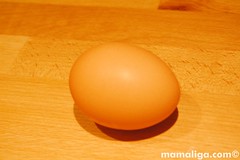




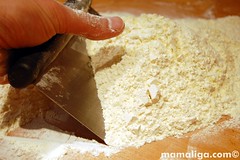
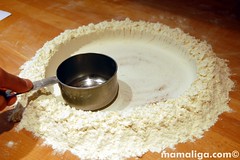
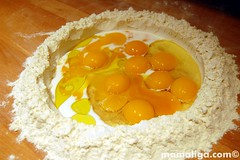
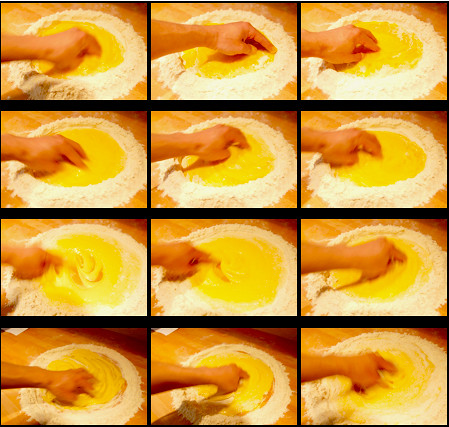
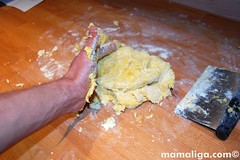
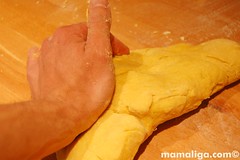
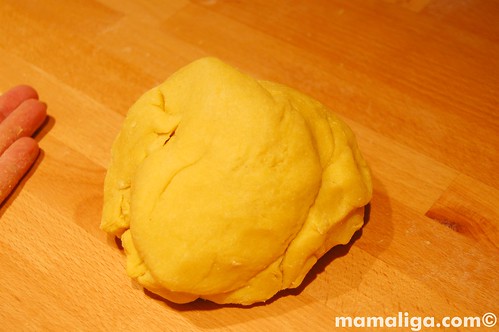
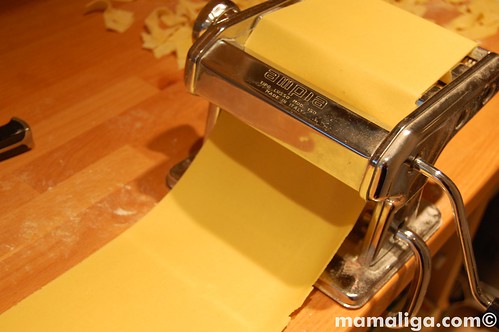

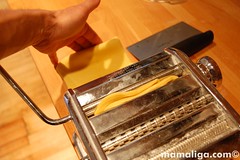
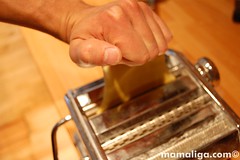
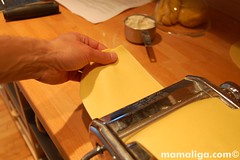

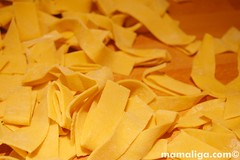
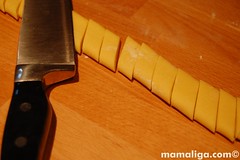
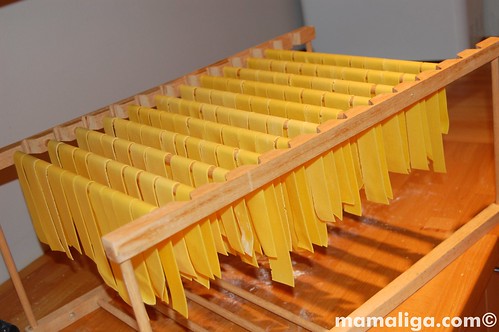


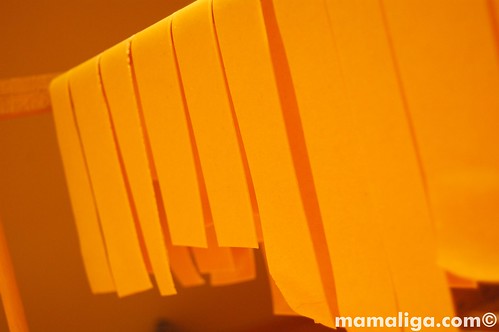

Wow – when you make pasta, you don’t mess around! We make small amounts, but nothing like that. Love the photo at the top of the post.
Thanks Mike!
It is always so much fun – not to mention delicious! Thanks for the comment!
Gabi.
Gabi, I can’t believe you don’t roll it by hand!
I know it is unexpected, but it is actually easier to roll it with a rolling pin than with the machine… Give it a try next time, and let me know what you think- it makes the pasta all at once, all the same thickness, it is a bit faster and then you can claim life-long rolling-pin masterhood status!
Great job on the pasta, it looks great!
Hahahahahahaha! Vanessa! That only would come from a true Italian like you!
I will absolutely roll it next time – I PROMISE!!
Thanks!
Gabi.
I made pasta with my girl scout troop because none of them, except my daughter, knew that you could. I wish your pictures had been up. So nice, so tidy, no sign of flour in every nook and cranny….
Fantastic post, Gabi! I love making fresh pasta here too. 🙂 Beautiful photos and a well presented methodology, my friend. I am glad to see you are back to food blogging, you have been missed! 🙂 Kepp ’em coming, my friend.
Anne Marie: Thanks for the comments! I bet those girls scouts’ life (and menu) got enriched! It isn’t quite that tidy to be honest – there’s still a lot of cleanup to be done afterward.
Sam: Thanks for your comment also! Yes – I am drawn back to blogging time after time – so I guess it is a good thing because it comes naturally. Although sometimes it is really hard to find the time for it –
cheers!
Gabi.
This looks like it would be so hard, but at the same time not. I am for sure saving up now to buy a pasta maker! This would save a lot of money I spend on pasta, especially since I eat it every day.
Thanks for this. You make it look so easy!
Amen to that Mike!
Really the pasta maker (a good one like the one mentioned in the post) is a good investment. I mean – you can roll the pasta by hand indeed – if you want to consider it an exercise – but with the pasta maker things are just much easier – not necessarily traditional.
thanks for the comment!
Gabi.
Making pasta from scratch seems like such a difficult process. I really will have to consider buying one of these machines.
Pasta is a great thing to always have and making it on your own is even better. Thanks for this tutorial. Really does make the process much less scary.
How long can one store dried fresh pasta ?
I suppose because of the raw eggs – not too many days ?
Rachel – Thanks for the comment! Home made pasta and sourdough makes one happy! You should try it!
Diana: I usually make the pasta the same day or store it in a paper bag in the fridge. But in Italy they basically dry it and store it in their pantry. Simple as that. The fact that the pasta dries so fast you really need not to fear.
But I would use it right away simply because it is so tempting.
Hope it helps!
When I read the ingredients on most pasta packages, it just says it has flour. Nothing mentioned about eggs. Is is possible to make pasta with just flour and water without eggs?
Tamara –
thanks for the comment!! The commercial pasta is made without eggs out of a very tough flour type. Depending on where you shop, you will also find pasta with eggs. Usually in the European food isle, etc.
My take on this is – if I want fast pasta, I use the store bought (usually Barilla), if I want egg pasta, I would make it myself as in this post.
Different pasta type calls for different sauces.
hope this helps.
I hope this doesn’t sound silly…but what is the recipe? 1 egg to 1 cup of flour? 3/4 cup of flour? “enough to mix it up with”? I am inspired to make my own pasta by your post, but I am unsure of the ratio. I have 5 chickens in my backyard laying me too many eggs to eat breakfast with and I really want to try this out!
Just a word after trying this….first, I use whole wheat flour because I’m always trying to get as much nutrition out of food as possible. Whole wheat is a bit more fragile, but it works fine and it’s delicious.
Second, kneading for 20 minutes made the pasta extremely tough and rubbery. When I used the method of rolling the dough through the pasta machine a few times, it worked perfectly. I have a hand-cranked noodle extruder and I made rotelli. After kneading the dough, the rotelli came out very rubbery, so I think the extruder actually develops the gluten in the flour somewhat as it’s pressed through the openings. In the future, I think I’ll just use the method of rolling the dough through the machine a few times regardless of the final machine I’m going to use to make the pasta.
It’s SO much fun for those of us who always loved playing with our food 😉
LOVE this post. I just bought a pasta roller this past week. My daughter (11) wanted to make it and since we make just about everything else homemade I said why not…I couldn’t believe how much fresher and delicious it tasted.
Question: you said to start off rolling with a #1. On my pasta roller #1 is the thinnest setting and is very hard to roll the first couple of passes. We started with a #6 and worked down. Do you think I need to knead my dough more and does it really matter what you start on?
Jacqualine!
Thanks for the post and I am so glad to see that you were inspired to make fresh pasta! isn’t soo much better than store bought??
You should always start off with the thickest setting. Go about 7-10 times on that setting until the dough is nice and shiny (love that feeling). Then go once on each setting down to the thinnest one you want. I always stop short of the thinnest setting as I like my pasta to have a bite to it (al dente) and I like it a little thicker.
The numbers are confusing though – I see some machines have #1 as the thinnest in your case or the thickest in mine.
The rule of thumb should be thickest setting to thinnest…
Hope it helps!
I just bought a pasta maker and my daughter (12) is going crazy with it. I love your post but I too am curiouse as to your recipe.
Thank you for stating that the dough should be the consistency of play dough. This helps me.
Do you ever add other ingredients to your dough>
Lynn – very glad to hear that! I realized that I didn’t post indeed the recipe! It is updated now – check it up above. I use:
5 cups flour (pastry flour)
6 XL eggs
the whole eggs can be substituted sometimes with 12 yolks for a richer and more colorful pasta.
Sometimes also I add a 1/4 cup of boiled, squeezed and pureed spinach but then I take out an egg (of the 6) since the spinach adds enough humidity to replace a whole egg (or 2 yolks if you go with the 12 yolks version).
Hope it makes sense – thanks again!
You talk about using pastry flour OR Italian 00 flour but they are vastlt different protein levels. Pastry flour is about 8% and Italian 00 like Caputo is about 11-12% according to what I read.
Dennis – You are right – It should be Italian Typo 00 flour. I’ll make the correction. Thanks for pointing that out!
This is amazing! You can save your money from buying pasta in stores 🙂 since you post this one, I’m gonna make my own pasta too 🙂
thanks!
Amy – not sure if you’ll save cash making your own pasta but will definitely be tastier!
Yummy, Looks so Delicious i wanna eat this pasta,i tried to make my own pasta thanx for posting.
“I keep dreaming about having a small flock of chickens in my Chicago NW suburban backyard (as I had back in Romania), but until the “Live Off Your Land” bill passes the House, I will have to be happy with the most cage-free, free-range, natural, brown eggs I could find on the market (sigh).”
You might be interested in this… http://www.youtube.com/watch?v=IOLwVrU9v7E It seems there is no bylaw prohibiting the raising of chickens in your area. Hope this helps.
Derek – Funny how no one have any clue of this. Heck, one should just share the eggs with neighbors and chances are no chicken police will find out… lol…
Great stuff! Any concern with pasta being air dried and stored even though having eggs as an ingredient?
I have a problem, when I make homemade pasta and then I dry it and store it, turns brown. What is causing this? And alot of people I talk to say the same thing.
Tips:
1. By covering the pot when you bring water to a boil, you are lowering the air pressure directly over the water, making it easier to boil.
2. Never mix pasta types in one pot.
3. Watch the cooking process carefully. Pasta can overcook very quickly.
4. If the pasta is to be used in a casserole, undercook it slightly. It will finish cooking to perfection while in the oven or skillet.
Eric – The fresh pasta doesn’t stand a chance for me to dry it because in my home it’s being prepared the day I make it. Although I don’t have a scientific explanation (I’d have to ask Alton Brown), Italians dry their pasta then eat it with no problems. If you feel unsure about it, dry it for say 5-6 hours then pack it in paper bags and store it in the fridge.
Phyllis – not sure. Try storing it in paper bags in the fridge after it dried for 5-6 hours. Not sure what to say here.
Karylle – thanks for the tips! At #1 the pasta water might foam up if covered and make a mess on your stove.
To avoid this you can either have the lid slightly off so there’s a small gap or you can add 1/2 tsp oil to the water. This will reduce surface tension and it prevents the foam to climb up. Also always use the biggest pot you have in the house to boil pasta. The bigger the better. And of course don’t forget the salt!!
Thanks!
In the pictures it looks like you added olive oil and milk to your dough. Is that true?
I do like this post! You have posted a very helpful post. Now I know how to make a home made pasta. Though it looks hard to do but with this photos with the texts, surely it’ll be wortha try to do at home.
My lasagna dough curls and cracks upon drying. I have been trying to dry it flat. Any tips?
My mom has taught me to do this when I was young. Can’t help reminisce those moments when I am getting in her nerves because I want her to do it over and over again. Nice post by the way.
Gabi, your pasta post and all the replies have been some of the most helpful I have found. I just bought a Marcato Atlas pasta roller on ebay but couldnt wait for it to get here. So this afternoon I made up a batch of yummy sauce and set to work makin some pasta. I used the food processor and half white flour and half whole wheat. I didnt knead too terribly long- maybe 5-6 min by hand and then rolled it out and cut it into fettucinni style noodles. I cooked them about 4.5 min till they floated. While we liked the flavor, the noodles were tough. Is this from overkneading?
@Tamara: absolutely. 1/2 cup flour, 2 tbsp water.
Thank you very much for this very informative pictorial, Gabriel! I enjoyed it very much and thought the tips for storage rocked 🙂 I’m always sad when I’m trying to figure out what to do with ALL the pasta. Brown bags FTW!
How long do I boil the pasta after I make it? If I don’t let it dry and use it right away I mean. Mmm I can’t wait to try this!
Kaley – it depends how “al dente” you want it. Give it something between 5-10 minutes. Make sure the water is boiling and it is salted BEFORE you add the pasta. Also make sure you stirr it often so it wouldn’t stick to the bottom of the pot. Let me know if this helped!
cheers!
After reading your site and all of the comments, I got out my pasta machine. It’s exactly like yours but probably 40 years old. I made the dough from King Arthur’s White Whole Wheat Flour. It’s whole grain but much less dense than regular whole wheat. Two cups of flour, two eggs, about two Tbsp of olive oil and a little cold water in the food processor and a ball of dough appeared. After resting about 15 minutes, I cut it in quarters and followed the protocol of the pasta machine. Result – a wonderfully rich, tender, flavorful pasta. Thanks for all the tips!!!
Oh, I forgot to mention that I used the spaghetti cut which makes an angel hair size pasta and boiled it two minutes. I wasn’t quite dry when cooked. And the dog loved the little bits that landed on the floor.
can anyone tell me why sometimes pasta does not cut all the way through on the fettecine or spaghetti settings, and other times it does?
Hi Lisa – It might be because the cutter rolls aren’t aligned properly and if the pasta is too soft they might not cut. It happens to me as well. A trick I’m using is to sort of push the rolling axle inward as I am rolling, if that makes sense. In other words as you are doing two moves in the same time with the same rolling hand – one rolling and the other move is pushing inwards. There, can I make it more confusing? lol…
Let me know if this worked…
Jane! Ha! that’s a discovery! Dogs like fresh pasta too! Way to go! I wonder what are their sauce preferences… Hehe. Thanks for the comment!
Lisa, when I made my first pasta in years the other day, my first batch of spaghetti didn’t cut through. It was too wet. When I added more flour, it cut beautifully.
What I’m trying to figure out is if I make fresh pasta for lasagna, do I cook the pasta before I add it to the lasagna? If not, how long should the lasagna cook with fresh pasta?